In this article, photographer shares his tips on photography reflections.
Why is a shooting angle capable of both creating and ruining a reflection photo?
Reflections are generated by the light source. However, it should not be displayed in the frame. Consider, for example, a landscape photograph of a small alpine lake reflecting the silhouettes of dark trees surrounding it.
Click here : High Quality Images
When creating such a scene, you must be careful not to let the sun get into the frame, otherwise it will be reflected in the lake and thereby simply ruin the picture. The sun will significantly reduce the reflection of the main element and the contrast of the scene, which will make your reflection almost completely unreadable.
Based on the particular scene being shot, adjust your own position or the position of your camera, make sure that you do not let the sun into the frame.
The best time to take reflections is usually in the early hours of the day or in the evening. Fog and colorful sunset clouds are a great facility. And with a cloudy sky, reflection can help make a boring sky interesting. You can also look for shadows: if your mirror surface is in a shaded area, this will help emphasize the reflection.
Weather also plays an important role in photographing reflections. On the one hand, they can improve composition with a gray or completely cloudless sky. But some conditions can still spoil the final idea. For example, too much wind or rain. When shooting reflections, wait for calm weather, the pond should be absolutely motionless. And there can be no talk of mountain rivers with their turbulent course.
Forget about composition rules if you want more interesting reflections
Photographing reflections is quite simple from a technical point of view. At first it will be easier for you to take reflections in the city. You can find a puddle reflecting a beautiful 200-year-old building – this is the beginning of the picture. Do not let composition rules limit your choice and frame construction, especially in the case of reflections.
Some of the most common rules for building a composition of a photograph are the rule of thirds, as well as the prohibition of placing the subject or horizon in the center of the image. However, when it comes to reflections, you will want to do everything exactly the opposite. This is due to the exact and almost geometric nature of natural reflections. Think about reflection on the calm surface of a lake. Sometimes it makes sense to balance the composition along the center line.
Why you should not use polarizing filters to capture reflections
The easiest way to get reflection is to use the surface of the water as a mirror. Puddle after rain, river, sea water remaining on the rocks during tidal outflow, lake, etc. Under such conditions, it is good to use a polarizing filter .
But in this case, even in landscape photography, a circular polarizing filter does more harm than good. It “kills” any possibility of the appearance of reflections on water and non-metallic surfaces. Even if you use the mirrored surface of a skyscraper in the shooting, the polarist will not let you do this. Thus, you have two options: either completely avoid using CPL, or use it to the maximum because of the design characteristics. You can focus your attention and the effect of polarization on something other than your reflective surface.
A polarizing filter should not be used when shooting reflections on a building, as this can damage the composition. To prevent the filter from killing the reflection in the frame, you should rotate the polarization so that it does not affect the reflection. Instead, the CPL will focus on other areas of the image that it can enhance rather than harm.
Camera settings for reflection photos
Diaphragm
First of all, make sure that you set the aperture to a sufficiently small value. If you’re in landscape photography, you probably already have a tripod. Its use minimizes camera shake, so you can safely close the aperture to obtain a greater depth of field.
And do not forget to check whether the object is in focus even in the reflected part. Alessandro starts with an aperture of f / 9.0 or f / 10 to try to maximize the depth of field and therefore adjust focus for the whole scene. If this is not enough, go to f / 16.
Shutter speed
Mount the camera on a tripod and try increasing the shutter speed. This will help you make the surface of the water smoother. Since water is your reflective surface, the reflection in this case will be clearer and more enjoyable. Increasing exposure also means keeping other parts of the composition under control. For example, clouds may begin to form stripes , or you will see that the sun moves inside the photo itself.
Since we said earlier that it would be better to avoid using CPL so as not to lose reflection on the water, you will need ND filters to increase the exposure time.
In case you need to balance exposure, you can use graduated ND filters instead. These filters help to increase the shutter speed. If you have a good tripod, a slow shutter speed will obviously not be a problem. Use the remote shutter or timer to avoid any vibration as much as possible. If you have a SLR camera, raise the mirror before shooting. The line between pure reflection and total disorder reflected in the water is really small.
Be creative
Reflection photographs are great for being creative. You can even take this direction as a basis to develop your own style. Reflections are confusing and surprise the observer. Whether it’s a puddle with an inverted building or an amazing landscape that is amazing.
Use horizontal or vertical reflections. And do not forget about the side! Especially if you shoot in an urban setting. Any reflection can be used so that it is more difficult for viewers to understand where it is on top and where down. Make them wonder which side is the reflection and which is not, let it not be obvious. Thus, the viewer will need more time to view the picture with interest.
Try to distort reality by showing an inverted world in the style of the movie “The Beginning” directed by Christopher Nolan. Or you can even hide your self-portrait in reflection or put some mysterious silhouette there. This will make the viewer feel that he is also part of the photo.
You do not need to adhere only to natural reflections in the photo. Take a closer look at buildings, artificial pools or even some sparkling objects around. All of them offer great opportunities for reflections in photography.
Conclusion
Reflections allow you to get unique and impressive shots. Go in search of ponds, windows of city houses and other reflective surfaces. Or immerse yourself in nature and take magnificent unique landscape photos with reflections.
In landscape photography, the landmarks are beautiful snow-capped mountains with a lake in front, serving as a mirror. But reflections are good not only in this genre! Even in street or architectural photography, you can create stunning romantic images with puddles of water after a rainstorm. Go for it!
For more information visit our website ImagesMall.com
 Universal Bloggers
Universal Bloggers




